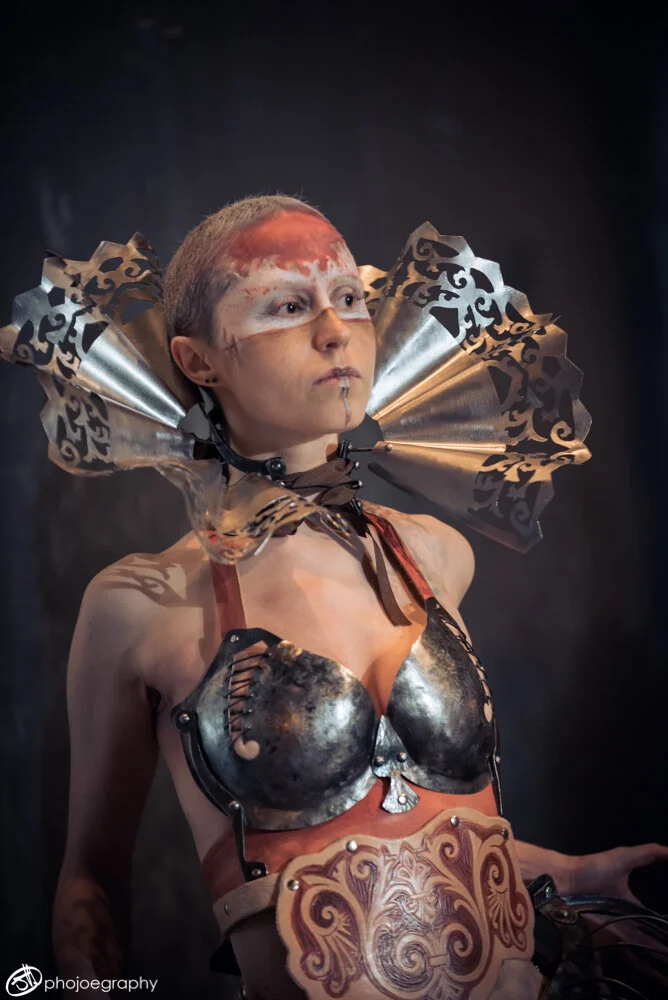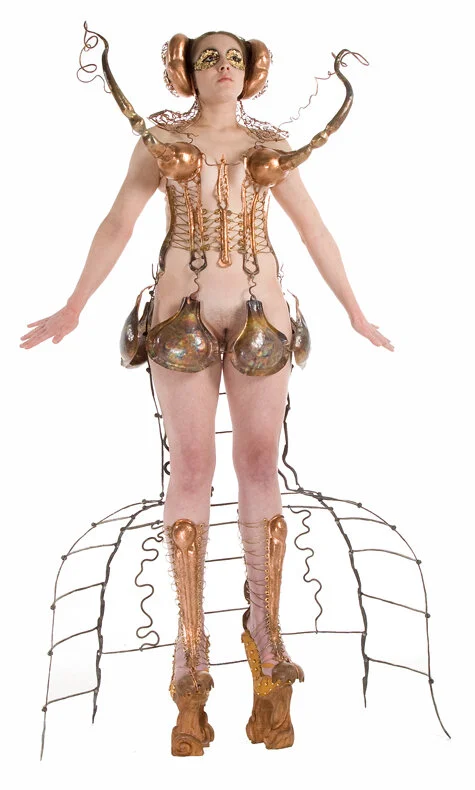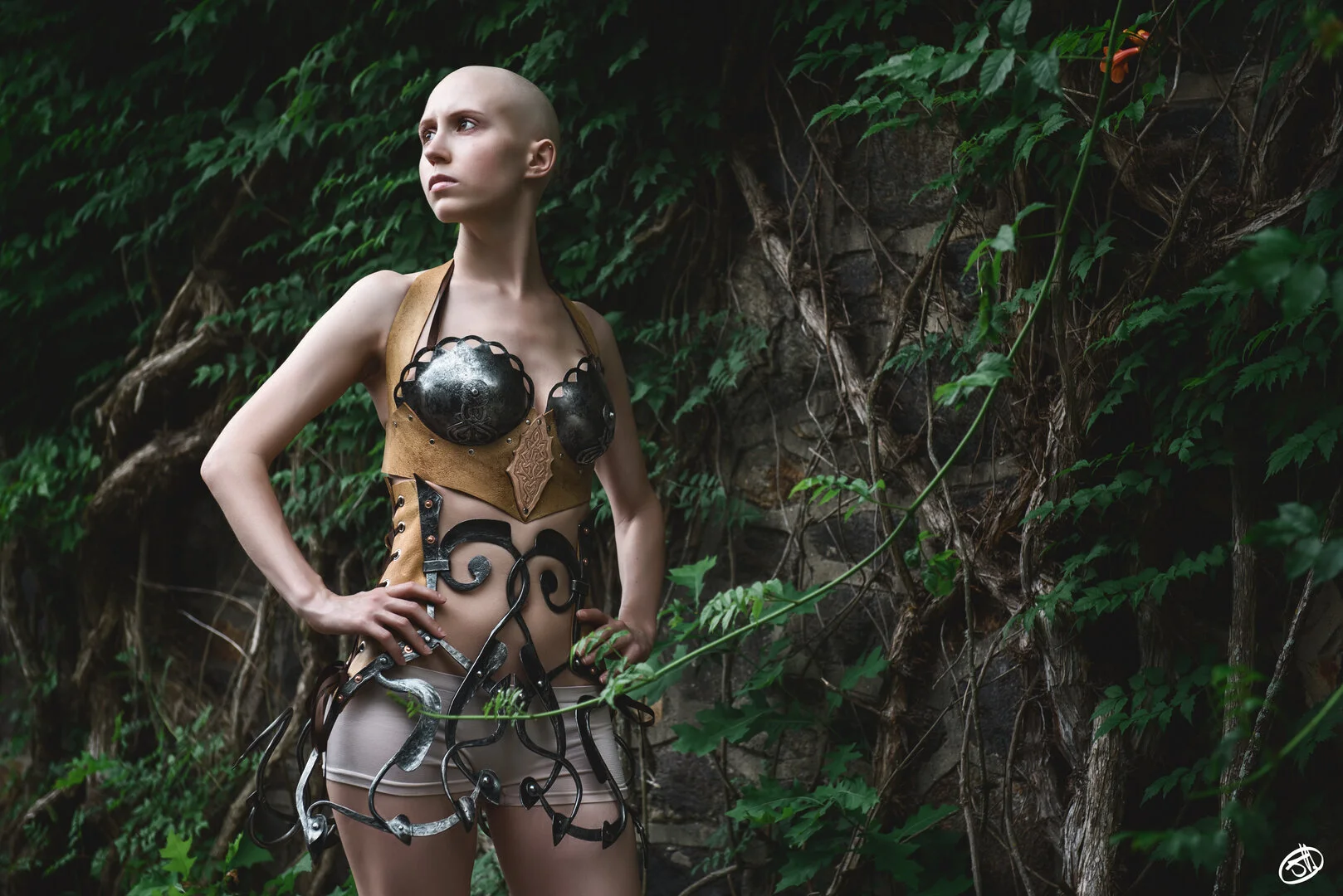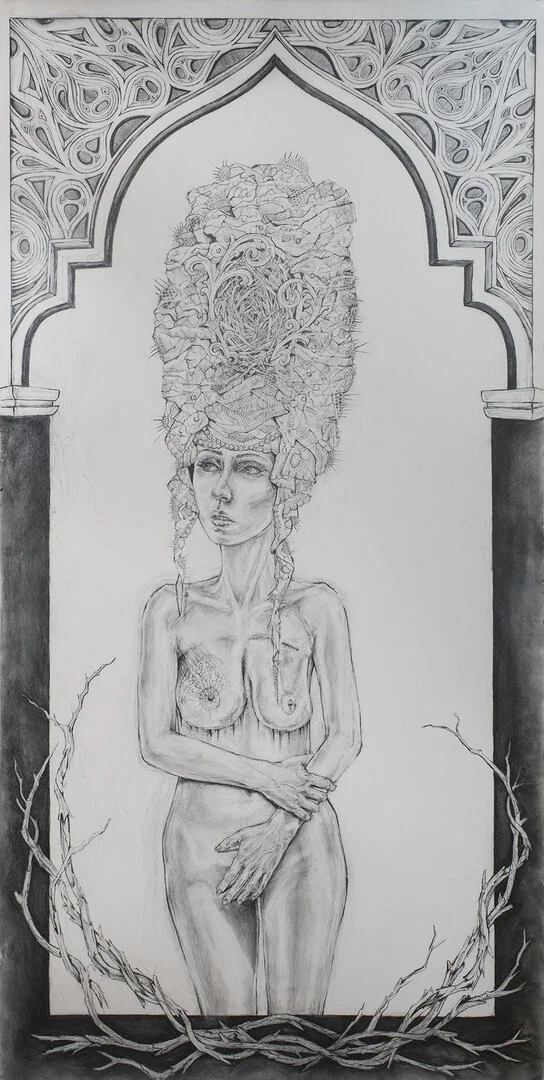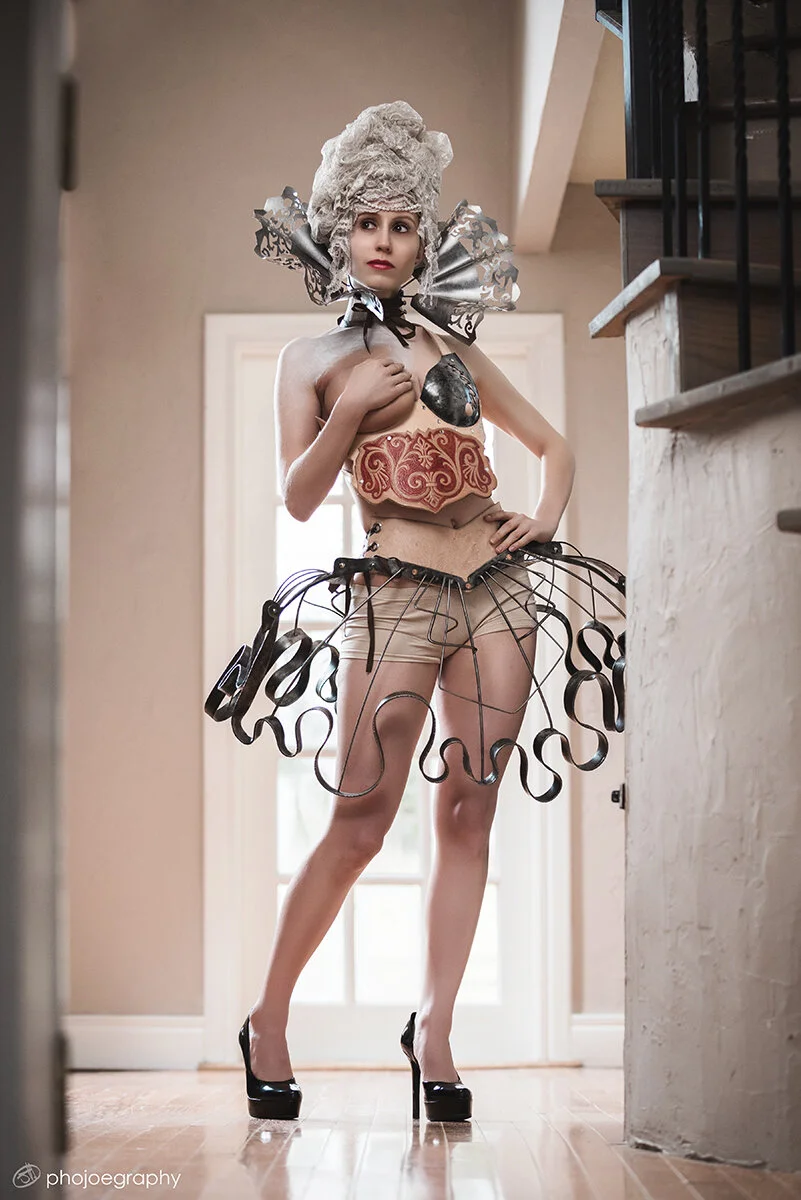Photo by Joe Hoddinott
Iron Maiden – Ellen Durkan’s Drawings in Steel
by David P. Kozinski
Blindheaded - Graphite 96 X 45; Photo by Ellen Durkan
The word chaos holds a special place in the vocabulary of artist/designer/blacksmith Ellen Durkan, as in “embrace the chaos,” or “finding your way in the chaos.” Trim and dark-haired, her speech is clipped, decisive and salty. The prowess of design, craft and attention to detail required in creating her “forged fashions” evinces a clarity of vision and steadiness of hand that are anything but chaotic. She refers to some of her designs as “drawing in steel,” a phrase that captures her fluency in the two contrasting media.
Nevertheless, to look at examples of the work she produces in her provocatively named Iron Maiden Forge is to experience complex emotions and a challenge to the senses. I first encountered a sampling of Durkan’s work at the Biggs Museum in Dover, Delaware in 2018, when she received a fellowship from the Delaware Division of the Arts. The blend of precision and anarchy in the ensembles – displayed on mannequins and busts – offered a melding of grace, control, delicacy and implied violence which left a lasting impression.
Available on her website, http://www.ellendurkan.com, a video tour of a Durkan show at DCAD (Delaware College of Art & Design) reveals some of the intricate, slightly larger-than-life drawings that accompany her three-dimensional works. The drawings can, but do not always, precede the dresses, bodices, headgear and other accoutrements that Durkan renders in metals, leather and other materials. She notes that, “some of the big, heavy dresses were meant to be worn but not walked around in. I wanted to make forged fashion – more individualized pieces created with one person in mind to wear.” The latter are made to accommodate movement and many are adjustable, often fixed to the body with leather straps or cinches.
Also seen on her website, a video of a live runway show gives the viewer a glimpse of the planning and improvisation involved in such a production. Models are helped into the outfits, much as women of a bygone age were helped with corsets and elaborate dresses by attendants, and knights were fitted into armor by squires. Durkan applies makeup with a brush to one model’s face and sprays masks of various colors around the eyes and foreheads of others. Asked if she usually does the makeup herself, she responds that, in one case, the cosmetologist she’d hired, “just didn’t get what I wanted,” so Durkan stepped in and did the job herself. She adds that ideally she’d have a makeup artist for such events but expense can be a limiting factor.
Many of the pieces suggest a fantasy warrior’s garb and present elements of eroticism and intimidation, for viewer and model alike. The fashions can appear both constricting and empowering. Metal epaulets project from shoulders like outlandish wings, antlers and tree branches seemingly grow from breasts, and feet are strapped into towering platform boots that suggest carved, narrow chairs. A video montage titled “Speak” quick-cuts through a series of women wearing a double-hinged mask, made of hand crafted steel and copper, that covers the lower half of the face and is affixed to a neck-length leather collar. The outer hinged piece is an elaborate grate which, when opened, exposes a relief mask, covering the nose and mouth, that also swings open. The artist agrees that this, and much of her work, is symbolic but prefers that viewers interpret it as they will.
She allows that several models have been nervous at the prospect of being arrayed in metal and leather gear. Most, however, seem to intuitively adopt the desired attitude of icy confidence when they are fully attired and realize they will be able to walk, albeit with some practice. Durkan admits that twice, during sessions with photographer Joe Hoddinott, with whom she has frequently collaborated, models have passed out from the heat. Fortunately, no one was injured. The mishaps occurred at repurposed sites – the Eastern State Penitentiary in Philadelphia and the Pennhurst State School and Hospital. The grim histories of these institutions provide eerie, gritty backdrops for the dramatic creations.
Antiope - Graphite 89 X 45; Photo by Ellen Durkan
While some models have sought her out, Durkan has often recruited people she knows. One series of images focuses on a friend who braved modeling while undergoing a course of cancer treatments, including chemotherapy and radiation. The design needed to be fabricated so as to avoid interfering with the medication port in the model’s chest. Likewise, she has created and documented an ensemble for a friend to wear during pregnancy, made to avoid putting weight on the model’s stomach.
At the time of our interview at her apartment in downtown Wilmington, Durkan was working on a large drawing of a woman wearing an ornamented collar, the copper version of which she let me hold. It was delicate, precisely tooled and substantial. When I observed that this and other items brought to mind Elizabethan laced collars and Bronze Age armor, Durkan offered that she was inspired by Gothic design and Victorian patterns, such as those found in the wallpaper of that era. She uses a variety of tools, including soft hammers for copper work and a jewelry saw to make the fine cuts in the metal that lend it the appearance of lace. She maintains a forge in a garage in North Wilmington, just outside the city, where she employs the traditional blacksmith’s hearth, hammer, tongs and anvil.
The eldest of nine siblings, Durkan grew up in nearby Newport, DE and was interested in art from early childhood on. Home-schooled until age 15, she took classes at Del Tech (Delaware Technical Community College). At age ten she began classes in drawing and ceramics at the Absalom Jones Senior Center in Wilmington. With a smile, Durkan remembers, “There was this group of older ladies – in their fifties, I’d say – talking about sex and doing their ceramics and there I was, age ten or eleven, doing my thing.”
In 2004 she received an Associate of Fine Arts degree at the Delaware College of Art & Design, followed by a Bachelor of Fine Arts from Corcoran College of Art & Design in Washington, D.C. and, in 2009, a Masters Degree in Fine Arts, Sculpture at Towson University in Baltimore. Durkan conducts weeklong workshops and demonstrations at conferences around the country. She teaches classes at DCAD, including figure drawing, and emphasizes the importance of practicing drawing technique.
Asked if she has enthusiasms outside of art, she replies that most everything in her life “revolves around the artwork and blacksmithing” leaving little time and energy for anything else. She added that she truly enjoys teaching, especially college-age students, and is not hesitant to criticize what she perceives as less than adequate rigor in their approach to assignments. She does not sugarcoat what may lie in store for them as they pursue their dreams. Paraphrasing what she tells students, she says, “The world isn’t interested in art. They won’t come looking for you.”
Durkan and model; Photo by Joe Hoddinott
Durkan notes that she spent years “doing restaurant work, mostly bartending” and has paid off her students loans, “about $100,000 worth.” She has also worked at a fabrication shop in Exton, PA, which makes “reproduction hardware…producing chandeliers and other fixtures people used to have installed in their houses,” as recently as last year.
A grouping of small, framed drawings greets visitors as they enter or exit Durkan’s apartment; the “trash monsters.” She made them about a decade ago while in graduate school, along with a series of tiny sculptures, “maybe two to three inches high,” created from bits of metal, paper, and fabric that she found and assembled. Rendered in graphite or charcoal, drawings with titles such as “A tout le monde,” “Trapped in an epic battle,” “Married couple” and “In the land of the blind, the one-eye is king,” are abstractions, but exude animation and twisted personality as little monsters tend to do. These creatures are not-so-remote forebears to the meticulously detailed drawings and the grand and elegantly outré forged fashions that have followed.
Durkan cites designer Alexander McQueen as an influence and notes his suicide at age 40. We kick around the relationship between clinical depression and making art, and agree that even artists with seemingly sunny dispositions have “been through some shit” that gives their work depth and renders it memorable. Whatever anarchic demons Durkan may have met, created or re-imagined along her path, they have not deterred her from creating work that demands attention in the gallery, onscreen or on the catwalk.
About the Author: David P. Kozinski received the 2018 Established Professional Poetry Fellowship from the Delaware Division of the Arts. His first full-length book of poems, Tripping Over Memorial Day was published by Kelsay Books in 2017. He received the Dogfish Head Poetry Prize, which included publication of his chapbook, Loopholes (Broadkill Press). Kozinski was named 2018 Mentor of the Year by Expressive Path, a non-profit that encourages youth participation in the arts. He serves on the Boards of the Manayunk-Roxborough Art Center and the Philadelphia Writers’ Conference. David Kozinski is Art Editor for the Schuylkill Valley Journal.
